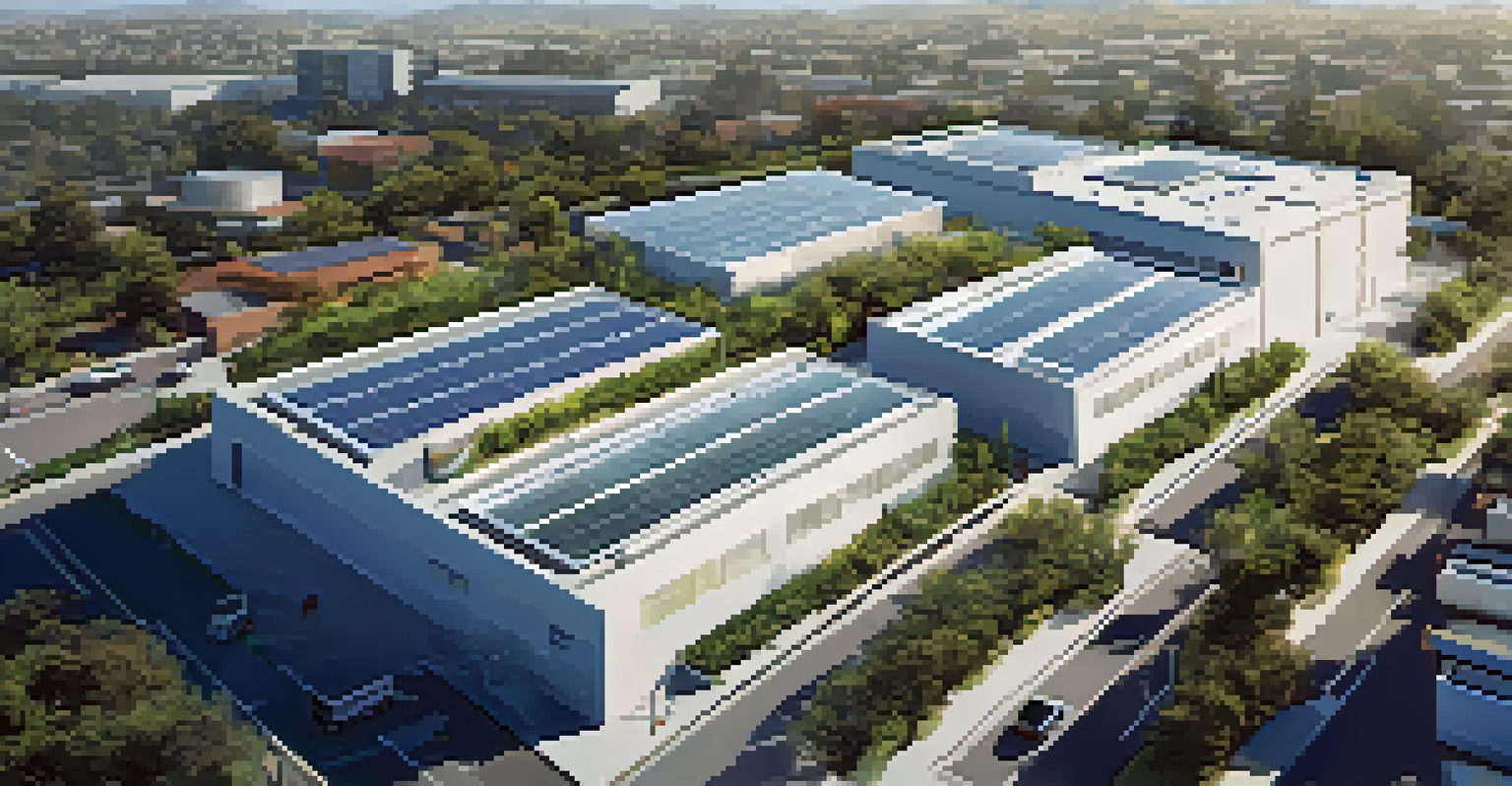Role of Technology in Enhancing Water Conservation in San Jose

Understanding the Water Crisis in San Jose
San Jose, like many cities, faces significant water challenges due to droughts and increasing population demands. This growing pressure has heightened the need for effective water conservation strategies. Understanding the local water crisis is crucial for residents and policymakers alike, as it sets the stage for exploring innovative solutions.
Water is the driving force of all nature.
With California experiencing severe drought conditions, San Jose has been actively seeking ways to optimize water usage. The reality is that a finite resource must be managed wisely to sustain the community's needs. As a result, technology has emerged as a powerful ally in this effort, offering tools and insights to help conserve precious water resources.
By recognizing the urgency of the water crisis, we can appreciate the role that technology can play in creating sustainable solutions. This awareness sets the foundation for discussing various technological innovations that are transforming water conservation practices in San Jose.
Smart Irrigation Systems: A Game Changer
Smart irrigation systems use sensors and data analytics to optimize watering schedules and amounts, ensuring that plants receive the right amount of water without waste. These systems can detect soil moisture levels, weather conditions, and even the specific needs of different plants. This precision helps homeowners and businesses alike conserve water while keeping landscapes vibrant.

For instance, a home equipped with a smart irrigation system can adjust its watering based on real-time weather forecasts, avoiding unnecessary watering during rainy days. This not only saves water but also reduces water bills, creating a win-win situation for residents. As more people adopt these technologies, the cumulative effect on water conservation can be substantial.
Technology Enhances Water Conservation
Innovative tools like smart irrigation and leak detection systems are crucial for optimizing water usage in San Jose.
In San Jose, the push for smart irrigation systems is part of a broader initiative to promote sustainable landscaping practices. By encouraging residents to invest in these technologies, the city is actively working towards a more water-efficient future, demonstrating how innovation can lead to positive environmental impact.
Water Usage Tracking Apps: Empowering Residents
Water usage tracking apps have become popular tools that empower residents to monitor their water consumption in real time. These apps allow users to set goals, receive alerts about high usage, and gain insights into their daily habits. The result is a greater awareness of personal water consumption, which often leads to more mindful usage.
We never know the worth of water till the well is dry.
Imagine a family that downloads a water tracking app and discovers that their daily shower habits are using more water than they realized. By adjusting their routine, they can significantly reduce their water consumption without sacrificing comfort. This newfound awareness not only helps the environment but can also translate into cost savings over time.
In San Jose, promoting the use of these apps aligns with the city's commitment to sustainable living. By providing resources and support for residents to track their water usage, San Jose is fostering a culture of conservation that encourages everyone to play their part.
Advanced Leak Detection Technologies
Finding and fixing leaks promptly is crucial for effective water conservation, and advanced leak detection technologies are making this easier than ever. These systems utilize sensors and machine learning algorithms to identify leaks in real-time, alerting homeowners and utility companies to potential issues before they escalate. This proactive approach can save gallons of water that might otherwise be wasted.
For example, a smart water meter can detect unusual patterns in water flow, such as a sudden spike that might indicate a hidden leak. By addressing these issues quickly, residents can maintain their water systems efficiently and prevent costly damage to their properties. This not only conserves water but also protects the infrastructure.
Community Engagement is Key
Engaging residents through apps and social media fosters a culture of conservation and accountability in water usage.
In San Jose, the adoption of leak detection technologies is part of a comprehensive strategy to enhance water management. By embracing these innovations, the city is taking significant steps toward reducing water waste and fostering a more sustainable community.
Rainwater Harvesting: Technology Meets Nature
Rainwater harvesting systems are gaining popularity as a sustainable way to capture and utilize rainwater for irrigation and other non-potable uses. These systems consist of catchment areas, storage tanks, and filtration mechanisms that allow homeowners and businesses to make the most of natural precipitation. This not only reduces demand on the municipal water supply but also promotes environmental stewardship.
For instance, a local business that implements a rainwater harvesting system can significantly lower its reliance on city water for landscaping. By using captured rainwater, they contribute to overall water conservation efforts while also reducing operational costs. This approach illustrates how technology can work hand-in-hand with nature to create sustainable solutions.
In San Jose, the city encourages rainwater harvesting through incentives and educational programs. By promoting this technology, residents and businesses can contribute to a more resilient water supply, showcasing how innovative practices can lead to positive environmental outcomes.
The Role of Data Analytics in Water Management
Data analytics is revolutionizing water management by providing valuable insights into consumption patterns, infrastructure performance, and potential areas for improvement. By analyzing data collected from various sources, such as smart meters and sensors, water utilities can make informed decisions to enhance efficiency and reduce waste. This data-driven approach is crucial for developing effective conservation strategies.
For example, if data reveals that water usage spikes during certain times of the day, utilities can implement targeted campaigns to encourage conservation during peak hours. This proactive strategy not only educates the public but also helps to balance demand on the water supply system. The result is a more sustainable approach to managing a vital resource.
Data Analytics Drives Efficiency
Leveraging data analytics allows San Jose to identify consumption patterns and improve water management strategies effectively.
In San Jose, leveraging data analytics is part of a broader initiative to modernize water management practices. By investing in technology and analytics, the city is taking significant strides toward creating a more sustainable future and ensuring that water resources are preserved for generations to come.
Community Engagement and Technology in Conservation
Engaging the community is essential for successful water conservation efforts, and technology plays a pivotal role in facilitating this engagement. Social media platforms, mobile apps, and online resources enable residents to share their experiences, tips, and challenges related to water conservation. This sense of community can motivate individuals to adopt more sustainable practices and hold each other accountable.
For example, a community-driven social media campaign in San Jose could encourage residents to share before-and-after photos of their water-saving efforts. This not only fosters a sense of pride but also inspires others to take action. When people see their neighbors making changes, they are more likely to follow suit, creating a ripple effect of positive behavior.

In San Jose, the city actively promotes community engagement through technology, creating platforms for residents to connect and share ideas. By harnessing the power of technology, the city is building a strong network of advocates for water conservation, demonstrating that collective efforts can lead to meaningful change.
Looking Ahead: The Future of Water Conservation in San Jose
As San Jose continues to face water challenges, the future of water conservation will undoubtedly rely on advancements in technology. The integration of new tools, systems, and community engagement strategies will be vital for fostering a culture of sustainability. By investing in technology today, the city can ensure a resilient water supply for tomorrow.
Looking ahead, we can expect to see even more innovations in water conservation practices, from improved smart irrigation systems to enhanced data analytics capabilities. These developments will not only benefit individual residents and businesses but will also contribute to the overall health of the community and the environment.
Ultimately, the journey towards effective water conservation in San Jose is an ongoing process that requires collaboration and commitment from all stakeholders. By embracing technology and fostering a culture of conservation, San Jose is paving the way for a sustainable future where water resources are cherished and protected.